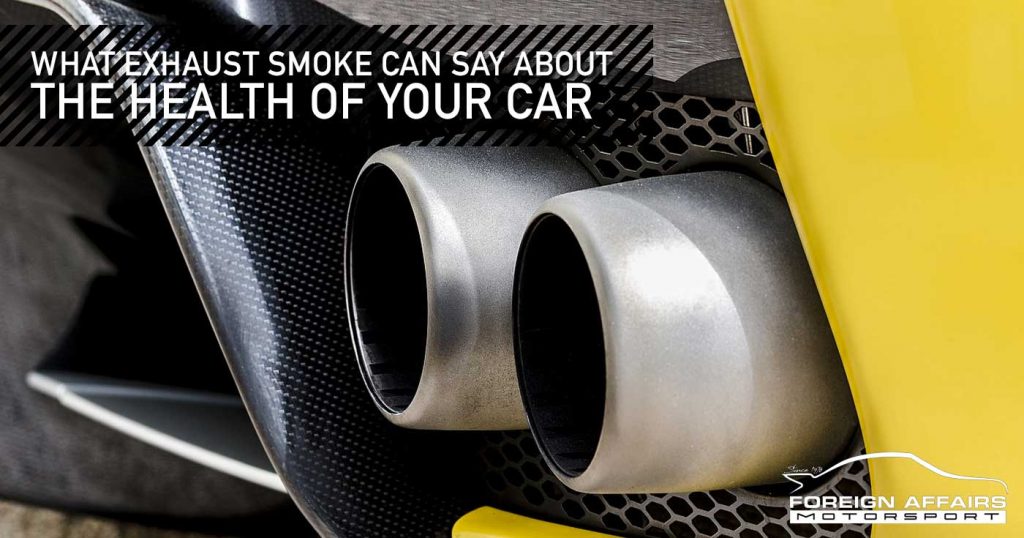What Exhaust Smoke Can Say About The Health Of Your Car

Outside of your car’s standard service it is difficult to know what kind of preventative maintenance to do, and what can go wrong if you don’t keep on top of things. Fortunately, your exhaust is a great indicator of potential issues. If your car needs something maintained or replaced, you’ll experience any one of the symptoms that follow, whether it is a weird sound or a huge puff of smoke. We got our master mechanics to talk about how they know something is wrong with a car by it’s exhaust.
The Importance of an Exhaust
There are two main jobs an exhaust needs to do – reduce engine noise and provide a path for exhaust smoke to escape that will not harm the cars passengers. As smoke and other gasses leave the engine, they are channeled into an exhaust manifold, which sends the emissions to the catalytic converter. In turbo-charged cars, the manifold connects to a turbo, which connects to a downpipe that then only connects to a catalytic converter.
The catalytic converter allows the smoke to pass through a mesh of precious metals, that react with particles in the smoke to create less harmful emissions. After the smoke passes through the catalytic converter, it enters a center section and then a muffler. The center section and muffler are designed to dampen the sound of the engine, with the muffler being the last piece of the exhaust before the smoke is released into the environment
Smoke Signals
The color of the smoke exiting the exhaust can tell a mechanic a lot about the health of the engine. In a healthy gasoline car, the engine produces white smoke that should not be dense and not be very visible. Very noticeable smoke is a sign that something isn’t right with your car
White smoke
Thick white smoke can be a sign of moisture in your exhaust, but this will clear up as your exhaust begins to heat up and evaporates the moisture. If white smoke continues after your car has warmed up, this is a sign of a coolant leak in the block, and is caused by the extra moisture from the coolant being burned off.
Heavy and thick white smoke is a sign that your car’s engine has a seal issue, and that the engine is no longer a closed system. This can be caused by a blown head gasket, and in some cases is a sign that the engine block may have a crack in it.
Blue Smoke
The most common cause of blue smoke is the engine burning oil. Burning oil means there is an oil leak somewhere in the engine, and the oil is being mixed with fuel and air, and is being ignited. The purpose of your car’s oil is to keep the engine lubricated and to collect any contaminants in the engine, keeping the engine clean. Leaking oil should always be repaired, as you run the risk of running the engine with an insufficient amount of oil, which will lead to a seized engine.
In turbocharged cars, blue smoke is also a sign that the turbocharger is failing. If your turbocharger has failed, oil may be leaking into the turbo, and being burned. A failed turbo is usually accompanied by a large amount of turbo whine.
Gray and Black Smoke
It’s often difficult to differentiate between gray and black smoke. Lighter gray smoke usually means that transmission fluid is being sucked into the engine and being burned. This is caused by a bad transmission vacuum modulator or bad fitment of the transmission after maintenance, such as a clutch replacement.
Darker, thicker smoke that looks more black than gray is sign that your car is currently burning too much fuel. This can be caused by a number of issues, ranging from blocked and dirty air filters, bad quality fuel or electric issues with your car’s engine computer. Black smoke should be repaired as it not only hurts your cars economy, but can lead to carbon build up that lowers your performance and can damage important engine internals like fuel injectors.
For all your car needs, whether it be maintenance, repair or modification, look no further than Foreign Affairs Motorsport, South Florida’s Premier German Auto Repair, Performance & Race Facility Since 1978.



